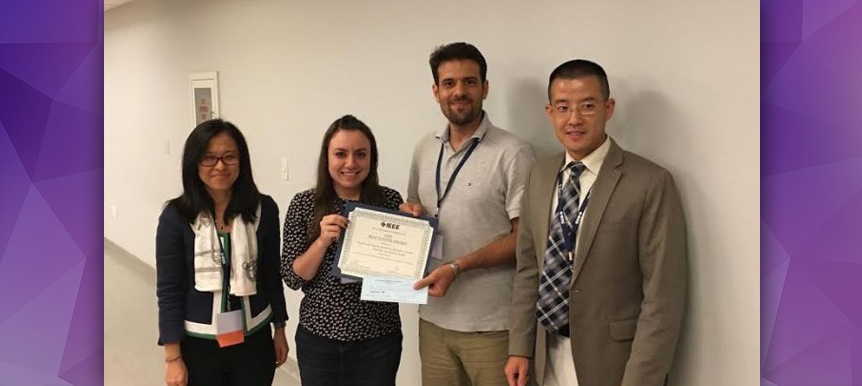Tandon Student Research Posters Win First and Second Place at IEEE Symposium

As more of the world increases its use of wireless devices and networks, researchers and telecommunication companies face challenges in how to balance the burden of billions of users with the demand for faster and more efficient networks. These challenges also occupy the minds of Electrical and Computer Engineering researchers at NYU Tandon, whose doctoral students and faculty members recently received poster awards for their research in advancements to network architecture at the 37th Institute of Electrical and Electronics Engineers (IEEE) Sarnoff Symposium.
Researching the economic complexities of resource sharing, Ph.D. students Fraida Fund and Shahram Shahsavari embarked on a project that compared technical and economic models of resource sharing within millimeter wave cellular systems, which use high-frequency waves that could be essential to future 5G networks. With the limited availability of wireless spectrum, resource sharing has been a hot topic in the tech world, as it can improve efficiency and maximize bandwidth. Fund and Shahsavari’s research revealed that spectrum sharing in millimeter wave 5G networks does not necessarily make it easier for service providers to enter the market, but that base station sharing does.
Upon winning the first-place award for the project, Shahsavari acknowledged the great feeling that arose when he and Fund realized that their “research is interesting to other members of the community.” With this added motivation, Fund and Shahsavari will continue their research with support from the National Science Foundation, NYU WIRELESS, and the Center for Advanced Technology in Telecommunications (CATT), as well as support from their collaborators, Professors Shivendra Panwar, Elza Erkip, and Sundeep Rangan.
Another solution to reducing the load on networks is to “prefetch” content in a local device’s cache and store that data for future requests of a popular website or file. In her research project, which won second place at Sarnoff, Ph.D. student Parisa Hassanzadeh aimed to understand the limits “when content distributed across the network — in the caches and the cloud — are correlated, resulting in transmission of redundant information,” as she explained. “Paying attention to these redundancies can further help with the efficiency of content delivery to users,” Hassanzadeh asserted.
The project was developed during Hassanzadeh’s internship with Nokia’s Bell Labs, the scientific and technological research company, and was undertaken in collaboration with Bell Labs researchers Antonia Tulino and Jaime Llorca and Professor Erkip. “We have been working extremely hard on this research project as a collective between academia and industry,” Hassanzadeh said, expressing excitement over the research team’s success at Sarnoff. Hassanzadeh will continue her work with Erkip, who is also her Ph.D. advisor, through funding from a National Science Foundation grant.
Erkip, an IEEE fellow and second vice president of the IEEE’s Information Theory Society, gave one of the symposium’s keynote speeches, highlighting the evolving theory and application of cooperative communications to wireless networks. She also discussed how cooperation between wireless users could be instrumental to the future of 5G and its goals to increase communication speed.
Erkip emphasized the importance for students to participate in poster competitions like Sarnoff, where they can network with and bounce ideas off others working in their field. “Taking part in the [poster] competition increases exposure to their work” Erkip said. “It’s nice that the students’ work is being recognized [and] that NYU in particular had two posters winning first and second place.”

 2025 Brooklyn 6G Summit — November 5-7
2025 Brooklyn 6G Summit — November 5-7 Sundeep Rangan & Team Receive NTIA Award
Sundeep Rangan & Team Receive NTIA Award 2025 Open House
2025 Open House








